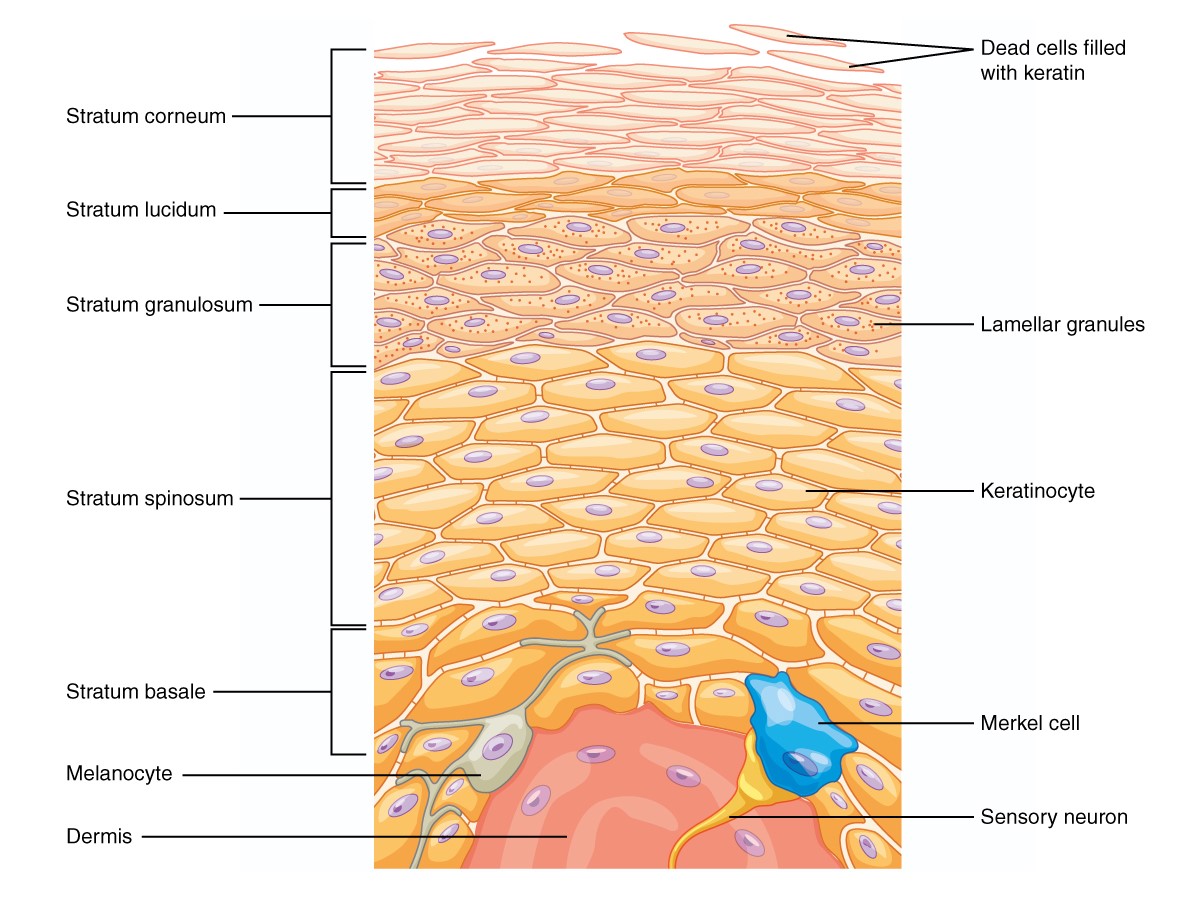Playlist
Show Playlist
Hide Playlist
Skin: Dermis
-
Reference List Pathology.pdf
-
Slides Skin Dermis Dermatopathology.pdf
-
Download Lecture Overview
00:01 Okay. That's the epidermis. 00:03 The dermis. You would think ah, that's just what's underneath. Well, no, there's actually some interesting stuff having to do with the dermis as well. So let's pay more attention to that. 00:12 There is an upper layer called the papillary layer. 00:15 The papillary layer is where the invaginations of the epidermis come in and out. So we have apparent papillae. 00:23 Why do we have that. Well in fact that allows us to stretch the skin without ripping it apart. We have surface area that we can now flatten out and pull. 00:33 So the papillary layer is good for giving us some elasticity of the skin overall. 00:38 It's composed of loose connective tissue. 00:41 So that makes sense. You need to be able to stretch it a little bit. 00:44 It also has capillary loops and the capillary loops that that vascular supply is only in the dermis. The epidermis is completely avascular. 00:56 It has to get its nutrition from the underlying capillaries, releasing the nutrients, and then kind of perfusing or diffusing into the upper epidermis layer. 01:09 There's loose connective tissue. There are capillary loops. And then we have the dermal papillae that intervaginate with the papillae that come from the epidermis. 01:20 Beneath that is the reticular layer. 01:22 These are going to be composed of denser connective tissue . 01:26 So these are going to be less elastic. 01:28 They're going to provide greater stability. 01:31 And that's because we have larger blood vessels that are in that area. 01:34 Those larger vessels branch and branch and branch become those capillary loops up there in the papillary dermis. 01:41 The collagen is very dense, relatively thick. 01:44 And that provides kind of tensile strength to the skin. 01:47 So it doesn't rip. Okay. 01:49 There are some other players that live in this region of the skin, and we're going to go through them in sequence. 01:56 I will say that these particular cells were named by either Germans or Italians, and it's fitting because they have to do with touch. All of these have to do with touch. 02:06 So the first player here is the Meissner corpuscle and it detects light touch. 02:11 It sits right at the dermal epidermal junction. 02:14 And if I'm just barely rubbing the surface of the skin, that's what those cells are sensing. 02:20 Deeper to that are going to be the Pacinian corpuscle. 02:24 The Pacinian corpuscles sit down in that dense connective tissue in the dermis. 02:28 They're going to be more deep pressure sensors. 02:33 They will also sense pain. 02:37 In and around in these areas are also the Ruffini endings. 02:41 This is a different cell type. 02:42 It responds to sustained pressure and skin stretching. 02:46 So it knows when I have stretched almost too far and says quit doing that. 02:50 And the Merkel disk, we already talked about the Merkel cell. 02:54 The connection between the Merkel cell and into the nerve is a Merkel disk, and it also is going to be reacting to light touch. 03:02 You will, you now know more about these other cells types in the skin than 99% of medical students or doctors anywhere in the world. 03:10 We won't really talk about these very much, with the possible exception of Merkel cell, because there is a Merkel cell carcinoma. 03:18 That is an interesting character and will be in a subsequent talk. 03:23 Finally, we get down into the hypodermis or to the subcutaneous fat. 03:27 And it's not just sitting there. 03:29 It actually is important for kind of puffing out the skin and giving it a rounder look. 03:34 So yes, I can I can look very emaciated or I can look more puffy. 03:40 A lot of that has to do with the subcutaneous fat beneath my facial skin. 03:44 Fat storage is important as a source of energy. 03:46 It's also very important for thermal regulation. 03:49 So the thickness and the amount of the fat really can influence how well it insulates.
About the Lecture
The lecture Skin: Dermis by Richard Mitchell, MD, PhD is from the course Review: Physiology and Structure of the Skin.
Included Quiz Questions
What is the primary function of the papillary dermis?
- It stores energy in fat cells
- It provides elasticity through loose connective tissue and dermal papillae.
- It gives structural support through dense collagen
- It produces new skin cells
- It forms a protective barrier
Which dermal mechanoreceptor detects deep pressure and pain?
- Meissner corpuscle
- Pacinian corpuscle
- Ruffini ending
- Merkel disk
- Langerhans cell
What distinguishes the reticular dermis from the papillary dermis?
- It contains more elastin fibers
- It lacks blood vessels
- It contains denser connective tissue and larger blood vessels.
- It has more nerve endings
- It produces sebum
Customer reviews
5,0 of 5 stars
| 5 Stars |
|
5 |
| 4 Stars |
|
0 |
| 3 Stars |
|
0 |
| 2 Stars |
|
0 |
| 1 Star |
|
0 |




